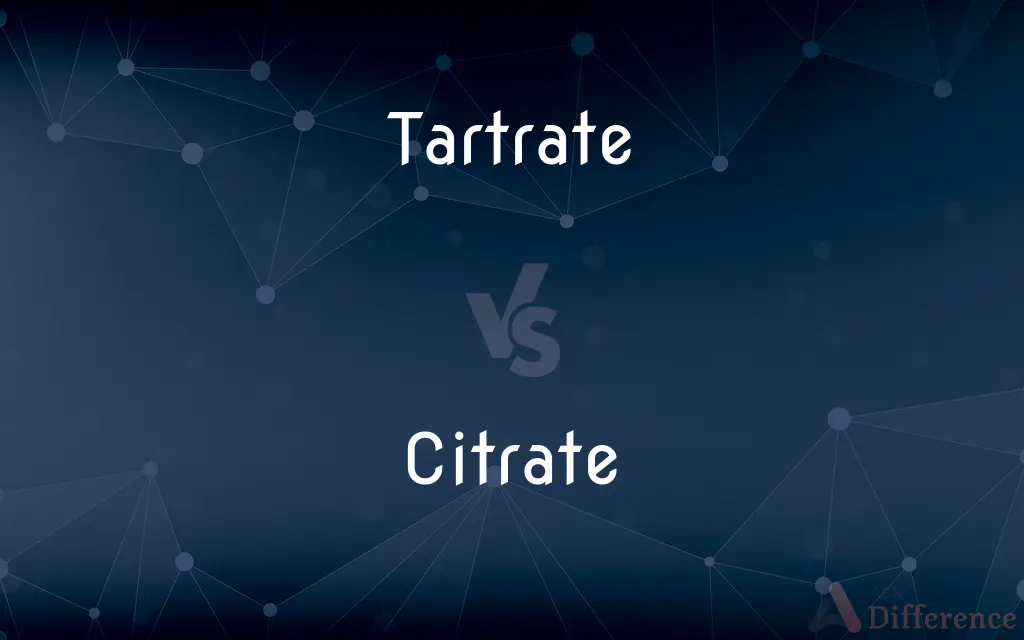Tartrate vs. Citrate — What's the Difference?
By Fiza Rafique & Maham Liaqat — Updated on April 4, 2024
Tartrate is a salt or ester of tartaric acid, often used in food and wine making, while citrate, derived from citric acid, plays crucial roles in metabolism and is a common food additive.

Difference Between Tartrate and Citrate
Table of Contents
ADVERTISEMENT
Key Differences
Tartrate, originating from tartaric acid, is commonly found in grapes and bananas, influencing the taste and stability of wines. On the other hand, citrate stems from citric acid, present in citrus fruits, and is pivotal in the citric acid cycle, an essential energy-producing pathway in cells.
Tartrate compounds are used in baking powder and as an antioxidant in food, providing a distinct tartness. Whereas, citrate is widely used as a flavor enhancer, preservative, and acidity regulator in food and beverages, contributing to a sour and slightly sweet flavor profile.
In the pharmaceutical industry, tartrate salts are used in medications to improve stability and solubility. Conversely, citrate salts, such as sodium citrate, play a significant role in medical settings as anticoagulants and as a means to adjust the acidity of urine.
In winemaking, tartrates can precipitate out of wine in the form of crystals, a natural process that does not affect the quality but may require stabilization techniques. Citrate, however, is not commonly associated with wine but is used in other beverages to enhance flavor and shelf life.
Both tartrate and citrate are involved in metal ion chelation, with tartrate being used in silver mirror reactions in chemistry labs, while citrate is utilized in medical imaging and as a chelating agent in detergents.
ADVERTISEMENT
Comparison Chart
Source Acid
Tartaric Acid
Citric Acid
Common Sources
Grapes, bananas
Citrus fruits
Key Uses
Wine making, food antioxidant
Flavor enhancer, preservative
Role in Metabolism
Not directly involved in major pathways
Central to the citric acid cycle
Pharmaceutical Uses
Medication solubility enhancer
Anticoagulant, adjusts urine acidity
Taste Profile
Tart
Sour and slightly sweet
Industrial Applications
Silver mirror reactions, stabilizing agent
Chelating agent in detergents, medical imaging
Compare with Definitions
Tartrate
Used as an antioxidant in food.
Tartrate is added to dried fruits to prevent oxidation.
Citrate
A salt or ester of citric acid.
Sodium citrate is used in beverages to enhance flavor.
Tartrate
Involved in winemaking.
Tartrate crystals can form in wine bottles, appearing as wine diamonds.
Citrate
Used as a medical anticoagulant.
Citrate solution is used during blood transfusions to prevent clotting.
Tartrate
Can act as a chelating agent.
Tartrate is used in silver mirror reactions due to its ability to chelate metals.
Citrate
Commonly used as a food additive.
Citrate is added to ice cream to stabilize the fat emulsion.
Tartrate
Found in natural sources.
Tartrate levels are particularly high in grapes and bananas.
Citrate
Central in the citric acid cycle.
Citrate plays a crucial role in cellular energy production processes.
Tartrate
A tartrate is a salt or ester of the organic compound tartaric acid, a dicarboxylic acid. The formula of the tartrate dianion is O−OC-CH(OH)-CH(OH)-COO− or C4H4O62−.The main forms of tartrates used commercially are pure crystalline tartaric acid used as an acidulant in non-alcoholic drinks and foods, cream of tartar used in baking, and Rochelle salt, commonly used in electroplating solutions.
Citrate
Acts as a chelating agent.
Citrate is utilized in detergents to soften water and enhance cleaning efficiency.
Tartrate
A salt or ester of tartaric acid.
Citrate
A salt, ester, or anion of citric acid.
Tartrate
(organic chemistry) any salt or ester of tartaric acid
Citrate
(organic compound) Any salt or ester of citric acid.
Tartrate
A salt of tartaric acid.
Citrate
To cause to form citrate.
Tartrate
A salt or ester of tartaric acid
Citrate
A salt of citric acid.
Citrate
Cause to form a salt or ester of citric acid
Common Curiosities
Can tartrate and citrate be used interchangeably in food?
No, they serve different functions and have distinct taste profiles.
Are tartrate and citrate natural compounds?
Yes, both are found in nature but are also synthesized for various applications.
Is citrate found in all citrus fruits?
Yes, citrate is a key component of citric acid, which is abundant in citrus fruits.
Can tartrate be used in all types of wine?
Yes, tartrate stabilization is a common practice in both red and white winemaking.
Is citrate used in non-food industries?
Yes, citrate is used in medical, cleaning, and personal care products.
Do tartrate and citrate have health benefits?
While not directly associated with health benefits, they are involved in food preservation and metabolic processes.
Can I find tartrate and citrate in everyday supermarket products?
Yes, they are commonly found in a variety of foods, beverages, and other consumer products.
Do tartrate and citrate affect the taste of food and drinks?
Yes, they are used to modify taste, adding tartness or a slightly sweet and sour flavor.
Can tartrate cause wine to go bad?
No, tartrate crystals are harmless and do not affect the wine's quality.
Are tartrate and citrate considered allergens?
They are not common allergens, but individual sensitivities may exist.
Are there any side effects of consuming tartrate or citrate?
In normal dietary amounts, both are generally safe, but excessive consumption can lead to gastrointestinal upset.
Is there a difference in nutritional value between tartrate and citrate?
Both are not significant sources of nutrition, serving primarily as additives.
How are tartrate and citrate produced industrially?
Both can be synthesized chemically or extracted from natural sources.
How do tartrate and citrate contribute to food preservation?
They act as antioxidants and stabilizers, extending shelf life.
Are there environmental concerns associated with tartrate and citrate?
In typical uses, they are not considered major environmental hazards, but industrial disposal must follow environmental regulations.
Share Your Discovery

Previous Comparison
Phyllite vs. Slate
Next Comparison
Respondentia vs. BottomryAuthor Spotlight
Written by
Fiza RafiqueFiza Rafique is a skilled content writer at AskDifference.com, where she meticulously refines and enhances written pieces. Drawing from her vast editorial expertise, Fiza ensures clarity, accuracy, and precision in every article. Passionate about language, she continually seeks to elevate the quality of content for readers worldwide.
Co-written by
Maham Liaqat















































